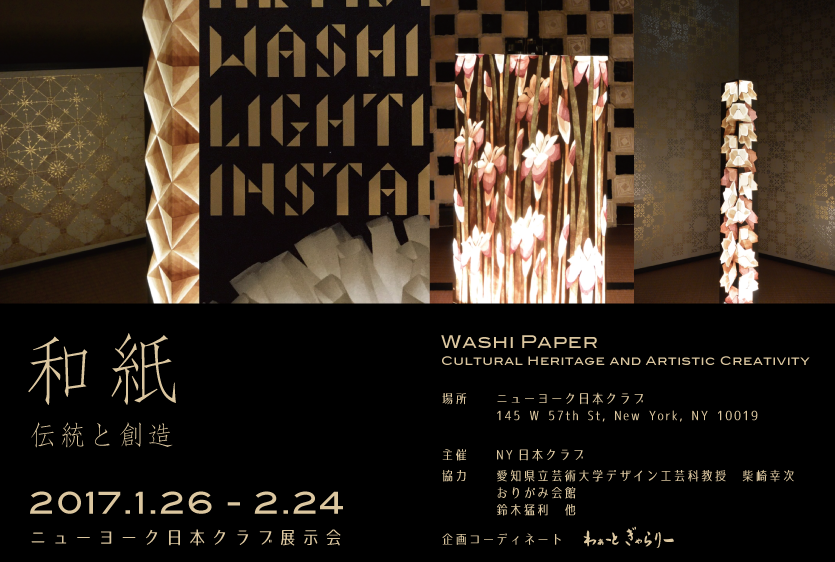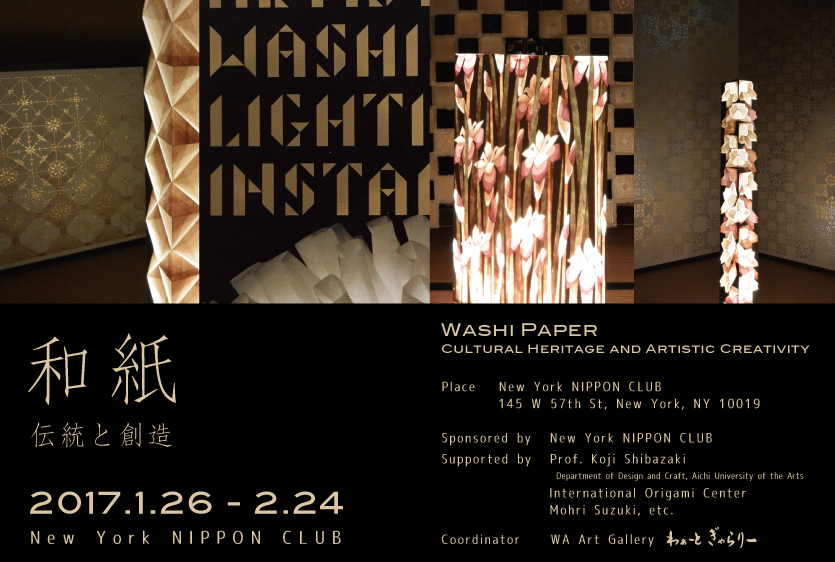
| タイトル | 和紙 伝統と創造 日本の和紙文化が形成してきた精神性と価値を世界に |
|---|---|
| 場所 | 日本クラブNY 145 W 57th St, New York, NY 10019 |
| 開催日時 | 2017年1月26日〜2月24日 |
| 主催 | NY日本クラブ |
| 協力 | 愛知県立芸術大学デザイン工芸科教授 柴崎幸次(しばざきこうじ) お茶の水 おりがみ会館 International Origami Center 截金 鈴木美賀子 (すずきみかこ) 書 鈴木猛利 (すずきもうり) 伝承折紙 渡部浩美 (わたべひろみ) 折形 有馬霞水 (ありまかすい) 和紙人形 内海清美(うちうみきよはる) 和art Gallery(わぁーとぎゃらりー) |
| 後援 | 愛知県立芸術大学 Aichi University of the Arts 豊田市 Toyota City 公益財団法人 紙の博物館 |
| 企画・コーディネーター | 和art Gallery 林祥子 |
はじめに
自然と調和する「薄くて、丈夫で、美しい」和紙は、その耐久性、強靱性を生かし、文化財の修復や地球環境に優しい製品として使われてきました。また、絵画や造形をはじめ、照明器具やインテリア素材等としても注目を集めています。
日本の和紙生産は古来より伝わり、手漉き紙の歴史は1300年とも言われています。特に江戸期は書写用紙を中心とした日本の代表的な産業として最盛期を迎え、各地でその風土気候を利用した原料の調達と独自の製法により、その地域の特性を生かした形で発展を遂げてきました。
近代になり洋紙や機械和紙の普及、そして原料栽培と紙漉きの手作業も海外移行がすすみ、和紙産業は大幅に縮小し、現代では伝統製法による日本の手漉き紙は特別な存在になりつつあります。
手漉き和紙は、製法や材料の違いから、単なる紙としての価値よりも紙そのものが発するイメージを受け取り、そこから新たな創造がうまれるという可能性があります。その素材がどのような植物から作られ、どのように手間暇かけて作られたものであるかなど、その風合いを決定づける様々な情報が人の美意識に影響を与えることでしょう。
目的と方法
本展では、和紙文化の伝承や引き継がれてきたものづくり観など和紙の精神性と価値を再認識し、現代のキーワードである環境問題などと合わせ、優美で機能的な和紙の世界観を伝えます。展示方法は古典的な美術の観点のみならず、創造を続けていく現在の姿として、世界で認められた和紙の多様性を伝えます。
会場は光を遮り、闇を創り出します。この演出は、従来の日本家屋で使われた唐紙などの考え方を参考にしており、箔など盛んに利用した時代に、 闇夜を行灯のような小さな光で演出した「日本家屋の光の思想」に通じる演出を日本クラブ展示室にて体験して頂けます。
展示内容
和紙伝統の紹介、和紙照明と伝統截金の箔が創り出す煌めきの美意識、伝統折紙と折形、現代和紙人形、そして書家自らが制作した手漉き和紙に描く書の数々を紹介します。
- 日本の照明文化である和紙照明の美しさを伝えます。和紙の光透過性と和紙によって創り出される柔らかい光、そして重ねによる色味の変化により、和紙照明作品だけでなく、会場全体に優美さと幽玄さを醸し出す効果があります。
- 柴崎幸次の「Nightface series」の中から花のシリーズ と幾何学模様のなどを展示。柴崎幸次の照明作品は、和紙を何層にも重ね貼りし それを透過した光の陰影の差で、不思議な立体感を創出する。 明るい場所に置くと和紙に包まれた白い箱に見えるが、暗い場所で内部の照明を灯すと複雑な “だまし絵”的な立体感が現れ、より暗くなるほどその立体感はリアルで迫真性が増す。
- 截金作品:大判和紙に、細い線や四角、円形などに截った金箔でつくる繊細な幾何学模様を表現する伝統技法。蝋燭の灯りのような小さな光の反射により煌く「共鳴する光の様」を愉しんで頂けます。
- 鈴木美賀子による截金作品は、截金としては珍しい自作の大判和紙に、繊細な幾何学模様を表現した屏風やタペストリーを中心に展示します。様々な陰影を映し出しながら自ら光を放つ和紙照明と、その光に照らされることによってきらめくような輝き見せる截金。この二つよって生まれる、“共鳴する光の様”を楽しんで頂きます。
- 伝統折り紙の数々。鶴や舟など、具体的な物の形に見立てた伝統的遊技折り紙作品。日本の伝統的な折り方の作品と日本の折り紙は、ヨーロッパの伝承的な折り紙であるパハリータ(ココット)や紙飛行機とは異なり、和紙の性質を活かした日本独自の折り紙として発展し、世界にOrigamiとして多くの愛好家を生み出しています。
- 伝統工芸として折紙を国内外の親善交流の活動を続ける折り紙会館から。
- 折形の数々。六百年以上の歴史を持つ武家社会の礼法の一つで、和紙を使い進物を包んで手渡すやり方と、儀式に使う和紙の飾りを総称する呼称です。上級武家のみが使用していた特別な和紙を目的別に使い分ける日本独自の文化です。
- 折り紙会館
- 手漉き和紙と書
- 書家鈴木猛利と柴崎幸次が共同で手漉き和紙を制作し、自ら制作した紙そのものが発するイメージを受け取り、書として創造した作品。
- 現代の和紙人形作品。
- 内海清晴。 和紙という「白」い「和」の自然素材の人形です。優美な古典の世界を創り出す日本を代表する和紙人形作家作品。
講演
愛知県立芸術大学デザイン工芸科教授 柴崎幸次
- 日本の和紙について。
- 本展示会で用いた照明作品と和紙の関係性について。
- 愛知県立芸術大学に和紙工房を作り、紙の研究と制作を行っていること。
- 本展示会用に自作した和紙について。
和紙は、古くから行灯などの日本の照明文化に深く関わってきました。和紙の美しさは、光を通した時に最も引き出されます。照明の光りに反射する金箔、銀箔、雲母など様々な素材を使った伝統技法があり、照明と和紙を使った作品が闇(暗いところ)の世界で醸し出す表現は、日本の美意識である陰翳の趣を見ることができます。また日本の和紙のサンプルを揃え、その多様性について解説を致します。

The Nippon Gallery at the Nippon Club in New York announces an exhibition on washi paper, which has played an important role in Japanese culture since the 8th century.
Washi paper is not only a traditional craft, but also an art form that reaches beyond its historical significance and into the present day through ever-changing forms of creative expression.
Introduction
Washi paper -“thin, strong, and beautiful” - is a symbol of Japanese craftsmanship. A work of art in itself, this traditional paper has not only found a place in the restoration of cultural properties by virtue of its unique durability, strength, and eco-friendliness, but also as a popular material for paintings, fine arts, lighting fixtures, and interior design.
Papermaking was first introduced to Japan from China in the 7th century by Buddhist monks who produced papers for writing sutras. By the year 800, Japan had developed its own method of paper production. There were various producing areas of washi paper throughout Japan and each of them took advantage of the indigenous raw materials produced by its unique climate and geographical characteristics. In the Edo period (1603-1868), washi paper became a major industry as not only Buddhist monks but also the commonality started to use washi papers for transcription.
Today, as modern technologies take over and mechanized paper production is able to manufacture similar-looking papers at a much lower cost and quality than authentic, handmade washi, this precious traditional craft is being threatened. However, with its wide method of production and use of a variety of raw materials, there is a possibility that handmade washi paper will give rise to a resurgence of this traditional craft through new and creative applications.
Purpose
In this exhibition, discover the beauty and functionality of washi paper firsthand through a variety of classic Japaneseart forms reinterpreted by contemporary artists anddesigned to introduce visitors to the historical and creative value of washi paper. Also, amid worsening environmental problems, this is a great opportunity to reappraise the value of washi paper made with natural ingredients.
In order to create darkness, all the windows are covered by washi paper, drawing on the ideas of karakami (thick paper often used for Japanese sliding doors), which are used in traditional Japanese houses. In this way, a subtle and profound atmosphere is created within the exhibition space, allowing for the quiet play of light and shadow as you are transported back to an era when the only source of light in the home emanated from a single washi lantern.
Exhibit contents
- “Nightface series” by Koji Shibazaki
- Explore the subtle beauty of Japanese illumination from the Edo period through lanterns made with washi paper. Usingthe unique and transformative translucency of layered washi paper, Shibazaki’s works create a mysterious spatial effect through his masterful control of shadow and light. In a well-lit space, his lanterns resemble simple, unadorned white boxes. However, when illuminated in darkness, an illusion of depth and space is revealed within.
- Artworks of cut gold leaf by Mikako Suzuki
- Constructed of handmade washi paper and adorned with intricate geometrical patterns made of individually hand-cut gold leaf, Suzuki’s subtly impressive folding screens and tapestries glitter in the gentle light of Shibazaki’s washi lanterns.
- Traditional origami by The International Origami Center
- The Japanese art of paper folding is completely different from its European counterparts, such as pajarita or cocotte en papier. Known around the world as origami, this method of paper folding was developed in Japan by taking advantage of washi paper’s distinctive features. From simple amusement to thoughtful ceremony, even today,origami remains a popular activity both in Japan and worldwide.
Another form of origami is called origata. A tradition established by the samurai class during the 15th century, origata is the art of wrapping gifts in paper, and was often used as decoration for special ceremonies. - Handmade washi paper and calligraphy by Mohri Suzuki
- In his continued exploration of the art of calligraphy, calligrapher Mori Suzuki returns to the fundamentals of his art through the physical act of making washi paper. Inspired by the intricate process of papermaking, his thoughts and feelings are expressed in every stroke of his expressive calligraphy.
- Washi dolls by Kiyoharu Uchiumi
- Using the distinctive properties of washi paper, Uchiumi’s pure white dolls and use of natural materials represent theaesthetic of Japan.
Lecture
Prof. Koji Shibazaki
Department of Design and Craft, Aichi University of the Arts
- Various Japanese washi paper
- Relationship between washi paper and lighting
- Professor Shibazaki’s current research and activities
- Professor Shibazaki’s handmade washi paper
Washi paper has been deeply entwined with traditional Japanese lighting since Edo period (1603 – 1868). By using various techniques and materials, such as gold/silver leaf and mica, each washi-made lantern exhibits a unique beauty as light passes through its translucent surface, illuminating the darkness. This lecture explores the application of washi paper in traditional lighting, Professor Shibazaki’s artwork, and the diversity of handmade Japanese paper.
In cooperation with
- Prof. Koji Shibazaki, Department of Design and Craft, Aichi University of the Arts
- International Origami Center
- WA art Gallery
- Cut gold leaf artist, Mikako Suzuki
- Calligrapher, Mohri Suzuki
- Traditional origami artist, Hiromi Watabe
- Traditional origata artist, Kasui Arima
- Washi Doll artist, Kiyoharu Uchiumi
Supported by
- Aichi University of the Arts
- Toyota City
- Paper Museum
- On-hyougu, Den
Coordinator
- WA Art Gallery

